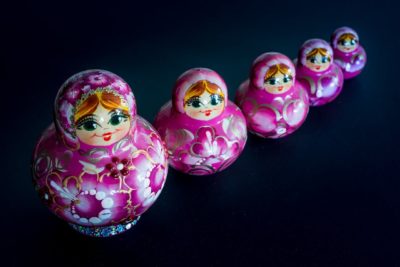
I recently got back from Saint Petersburg, Russia. After jaw-dropping palaces and vodka shots, we had to buy a few of those little nested Russian dolls, the painted, hollow, wooden figurines that open to reveal smaller dolls within, which open to reveal still smaller ones. Once the vodka fog lifted, this got me to thinking about a largely overlooked writing tactic.
Writing well from the point of view of your characters is a vital skill. Once in a while you stumble across a good example of “nested” viewpoint (not to be confused with “nested stories,” in which one story is contained within another).
In nested viewpoint, the narrator of the moment relates another character’s first-person story verbatim, just as it was told to her. That second viewpoint is nested inside the first, like a Russian doll. It’s not exactly a viewpoint shift; the original narrator is technically still the narrator, but now she’s telling that guy’s story in his words.
A great example is in The Time Machine, by H.G. Wells, published in 1895. This novella opens in the first-person point of view of a dinner guest. The narrator begins with the after-dinner fireside-and-drinks conversation among the several guests, as their host begins explaining with deliberate purpose why he’s summoned them, easing them into the fantastic by challenging their worldviews:
“You must follow me carefully. I shall have to controvert one or two ideas that are almost universally accepted. The geometry, for instance, they taught you at school is founded on a misconception.”
The host, aka The Time Traveler, engages his guests in argumentative dialogue for the first three chapters, but in the fourth we enter full-bore into his first-person story, until the final chapter. The bulk is his uninterrupted narrative, complete with quotation marks bracketing each paragraph as it would in dialogue.
Viewpoint strategies must be chosen for the purpose of story. Why tell the protagonist’s story in this way? Why not just make him the first-person narrator from the get-go? That would have been easier. But by having the first narrator— presumably Wells himself— relate the second narrator’s story we get the authenticity and experience of his initial skepticism giving way to wonder and belief.
Arthur Conan Doyle’s Sherlock Holmes stories are almost all narrated by stalwart Dr. Watson. This allowed Doyle to maintain the image of Holmes’s untouchable genius by denying us access to his innermost thoughts. Access, Doyle knew, spoils illusion. But on occasion, we would get a large chunk of nested story narration delivered by Holmes through Watson, such as in “The Adventure of the Empty House” (1903), in which Holmes returns from his presumed death in Reichenbach Falls and spends pages detailing his miraculous recovery. As listener, Watson is still in the first-person, but as speaker, Holmes essentially is as well. The beauty in this is that Holmes can self-edit what he relates to Watson without allowing us into his mind. Doyle’s overall strategy of aloof brilliance is thus maintained.
Both examples are from works more than a century old and the device may sound a bit archaic. Would publishers and readers still accept it today? Yes, if it’s written well enough, especially if it’s a period piece. But it’s a challenge to pull it off believably.
The analogy of the Russian doll can only carry us so far. There might be six or seven dolls nesting inside a single doll. I doubt that even the best writer can get away with nesting more than a single viewpoint within another, but if some have managed it, I scrape and bow in deference and toast them with vodka.

Niki Kantzios
Thanks for a really interesting discussion of a special kind of voice. The more I think about it, the more examples I come up with out of literature. Can’t argue with success!
Ken Pelham
Thanks, Niki!
What examples did you find?
Nancy J. Cohen
Nice analogy. I’d love to visit St. Petersburg. Re the nesting dolls, I researched these matryoshka dolls for my current WIP. A few of them sit on my shelves at home.
Ken Pelham
Thanks, Nancy!
Now that you mention it, I think the nested dolls would make excellent furnishings for mystery novels. The very essence of the dolls suggests mystery within.